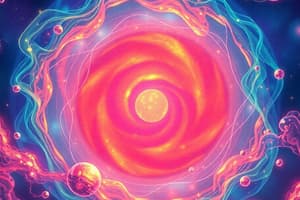Podcast
Questions and Answers
What does the principle of conservation of energy state?
What does the principle of conservation of energy state?
- Energy can be transferred or stored, but never created or destroyed. (correct)
- Energy can be both created and destroyed depending on the system.
- Energy can be destroyed but not created.
- Energy can be created but not destroyed.
Dissipated energy is considered useful because it efficiently contributes to the intended function of a system.
Dissipated energy is considered useful because it efficiently contributes to the intended function of a system.
False (B)
Define 'power' in the context of energy transfer.
Define 'power' in the context of energy transfer.
Power is the rate of energy transfer or the rate of doing work.
A mobile phone transforms chemical energy to useful energy, but some energy is ______ as thermal energy.
A mobile phone transforms chemical energy to useful energy, but some energy is ______ as thermal energy.
Match the processes with their descriptions:
Match the processes with their descriptions:
In conduction, how is energy transferred between particles?
In conduction, how is energy transferred between particles?
Thermal conductivity measures how slowly energy is transferred through a material.
Thermal conductivity measures how slowly energy is transferred through a material.
Explain why convection occurs primarily in liquids and gases.
Explain why convection occurs primarily in liquids and gases.
In convection, when a region of gas or liquid is heated, its ______ decreases.
In convection, when a region of gas or liquid is heated, its ______ decreases.
Match each item with its most appropriate description regarding energy transfer:
Match each item with its most appropriate description regarding energy transfer:
What happens to air particles near a radiator?
What happens to air particles near a radiator?
A powerful machine is always one that exerts a strong force.
A powerful machine is always one that exerts a strong force.
What is the formula to calculate power?
What is the formula to calculate power?
One watt is equal to one ______ of energy transferred per second.
One watt is equal to one ______ of energy transferred per second.
Match the motor to calculated power (P = W/t):
Match the motor to calculated power (P = W/t):
What is the process where vibrating particles transfer energy to neighboring particles?
What is the process where vibrating particles transfer energy to neighboring particles?
Particles in liquids and gases are less free to move around, which is why they usually transfer energy by convection instead of conduction.
Particles in liquids and gases are less free to move around, which is why they usually transfer energy by convection instead of conduction.
Why does the warmer and less dense region will rise above denser, cooler regions?
Why does the warmer and less dense region will rise above denser, cooler regions?
Radiators create ______ current
Radiators create ______ current
Match the description:
Match the description:
Flashcards
Energy Conservation Principle
Energy Conservation Principle
Energy can be transferred usefully, stored, or dissipated, but never created or destroyed.
Power
Power
The rate of energy transfer, or the rate of doing work, measured in watts (Joules per second).
Conduction
Conduction
Process where vibrating particles transfer energy to neighboring particles.
Convection
Convection
Signup and view all the flashcards
Thermal Conductivity
Thermal Conductivity
Signup and view all the flashcards
Convection Currents
Convection Currents
Signup and view all the flashcards
Dissipated Energy
Dissipated Energy
Signup and view all the flashcards
Study Notes
Reaction Rate
- For the reaction A → B, the rate of disappearance of reactant A is expressed as -d[A]/dt.
- The rate of appearance of product B is expressed as d[B]/dt.
Rate Law
- For a reaction aA + bB → cC + dD, the rate law is 𝑟𝑎𝑡𝑒=𝑘[𝐴]^𝑥[𝐵]^𝑦.
- k is the rate constant.
- x is the order of the reaction with respect to reactant A.
- y is the order of the reaction with respect to reactant B.
- x + y gives the overall order of the reaction.
Integrated Rate Laws
- Zero Order: rate = k, [A]_t = -kt + [A]0, half-life is 𝑡{1/2} = [A]_0/2𝑘
- First Order: rate = k[A], ln[A]_t = -kt + ln[A]0, half-life is 𝑡{1/2} = 0.693/𝑘
- Second Order: rate = k[A]^2, 1/[A]_t = kt + 1/[A]0, half-life is 𝑡{1/2} = 1/(𝑘[A]_0)
- Second Order: rate = k[A][B] (if [A] = [B]), 1/[A]_t = kt + 1/[A]0, half-life is 𝑡{1/2} = 1/(𝑘[A]_0)
- Second Order: rate = k[A][B] (if [B] >> [A]), ln[A]_t = -kt + ln[A]_0 where k' = k[B]0, half-life is 𝑡{1/2} = 0.693/𝑘'
- Second Order: rate = k[A][B] (if [A] >> [B]), ln[B]_t = -kt + ln[B]_0 where k' = k[A]0, half-life is 𝑡{1/2} = 0.693/𝑘'
- When [A]_0 >> [B]_0, [A]_t ≈ [A]_0, resulting in a pseudo-order rate law: rate = k'[B]^n, where k' = k[A]_0^m
- In pseudo-order rate laws, k' = k[A]_0^m, which is the pseudo-order rate constant
Arrhenius Equation
- Relates the rate constant to temperature and activation energy: k = Ae^(-Ea/RT).
- k is the rate constant.
- A is the frequency factor.
- Ea is the activation energy.
- R is the gas constant (8.314 J/mol·K).
- T is the temperature in Kelvin.
- Alternate form: ln(k2/k1) = Ea/R(1/T1 −1/T2).
Catalysis
- Catalysts increase reaction rates by reducing activation energy.
- Catalysts remain unchanged during the reaction.
- Homogeneous catalysts exist in the same phase as the reactants.
- Heterogeneous catalysts exist in a different phase from the reactants.
Reaction Mechanisms
- Reaction mechanisms consist of elementary steps that sum to the overall reaction.
- The rate-determining step is the slowest step and controls the reaction rate.
- Intermediates are formed in one step and consumed in a later step.
Studying That Suits You
Use AI to generate personalized quizzes and flashcards to suit your learning preferences.




